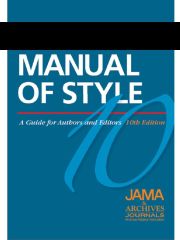No one wants to be a don’t, a fashion faux pas splashed in full color across the page of a widely circulated fashion magazine. In an attempt to protect the identity of the don’t, one such periodical places black bars over the eyes of each fashion offender. Is this technique sufficient to spare the person the potential humiliation and ridicule that may follow? The AMA Manual of Style offers a resounding no.
 Reports of medical cases and research can be greatly enhanced by a photographic or illustrative example of the condition under discussion. Imagine reading a case report of a unique rash with no accompanying photograph, or an article about a newly developed surgical technique without before-and-after images or an illustration of the surgeon’s approach. A picture, it is often said, is worth a thousand words (see 7.5.4, Clichés).
Reports of medical cases and research can be greatly enhanced by a photographic or illustrative example of the condition under discussion. Imagine reading a case report of a unique rash with no accompanying photograph, or an article about a newly developed surgical technique without before-and-after images or an illustration of the surgeon’s approach. A picture, it is often said, is worth a thousand words (see 7.5.4, Clichés).
Medical journals have a responsibility to protect patients’ rights to privacy and anonymity, including the deletion of patients’ names, initials, and assigned numbers from case reports; the removal of identifying information from radiographs, digital images, and laboratory slides; and the deletion of identifying details from descriptions of patients or study participants in published articles (see 5.8.2, Patients’ Rights to Privacy and Anonymity).
Until the late 1980s, placing black bars over the eyes of patients in photographs was accepted as a way to protect their identities. However, some journals began to discontinue this practice when it became apparent that bars across the eyes do not preserve confidentiality (see 5.8.2, Patients’ Rights to Privacy and Anonymity). The Uniform Requirements for Manuscripts Submitted to Biomedical Journals concurs, noting that “masking the eye region in photographs of patients is inadequate protection of anonymity.”1
When detailed descriptions, photographs, or videos of faces or identifiable body parts are included with a manuscript that might permit any patient to be identified (even if only by the patient himself or herself), authors should obtain written permission from the identifiable patients (or legally authorized representatives) to publish the information. An example of the patient permission form used by JAMA and the Archives Journals is available at http://pubs.ama-assn.org/misc/patientconsent.pdf. The journal may wish to state (eg, in the Acknowledgment) that the patient shown and/or described has provided written permission.
If such permission cannot be obtained, another approach the journal might take is to remove nonessential potentially identifying details. For example, a patient described as a “20-year-old woman from suburban St Louis with end-stage renal disease undergoing dialysis” could be rewritten as a “young adult woman with end-stage renal disease undergoing dialysis.”
However, altering descriptive characteristics (eg, sex) is not appropriate because it is a form of falsification and may be misunderstood by readers and others conducting secondary analyses of published reports. The best way to provide complete information while protecting patient rights is to obtain informed consent for publication. Informed consent for this purpose requires that an identifiable patient be shown the manuscript to be published or waive his/her right to review the paper.1
To protect patients and to spare potential legal woes, medical journals should not use black bars on photographs in the attempt to preserve confidentiality. The image should be replaced with one that has permission for publication or one in which identifiability is not an issue, or the article should run sans photograph.—Stacy L. Christiansen, MA
1. Uniform Requirements for Manuscripts Submitted to Biomedical Journals: ethical considerations in the conduct and reporting of research: privacy and confidentiality—patients and study participants. http://www.icmje.org/ethical_5privacy.html. Accessed May 9, 2011.
